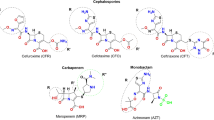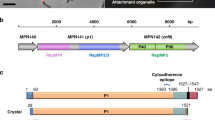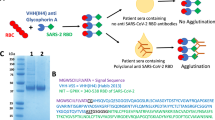Abstract
IT is generally accepted that the penicilloyl group is the major determinant in penicillin allergy1,2. It is probably formed in vivo either by the coupling reaction between the penicillin molecule and proteins3,4, or by way of penicillenic acid5. Various in vitro and in vivo methods, including passive haemagglutination, skin test, as well as passive transfer1,2, have been used for the detection of anti-penicilloyl antibodies. Because the detection of antibodies depends on the sensitivity of the assay used, development of more sensitive techniques seemed worth while, and fluorescence polarization6 and a sensitive passive haemagglutination method2 for detection of anti-penicillin antibodies were recently described. A very sensitive assay for the determination of extremely low concentrations of antibodies to defined determinants, making use of haptens coupled chemically to bacteriophage, has been reported recently by Mäkelä7 as well as by Haimovich and Sela8. We have now extended this method to the detection and quantitative determination of anti-penicilloyl antibodies.
This is a preview of subscription content, access via your institution
Access options
Subscribe to this journal
Receive 51 print issues and online access
$199.00 per year
only $3.90 per issue
Buy this article
- Purchase on Springer Link
- Instant access to full article PDF
Prices may be subject to local taxes which are calculated during checkout
Similar content being viewed by others
References
de Weck, A. L., and Blum, G., Intern. Arch. Allergy, 27, 221 (1965).
Levine, B. B., Fellner, M. J., and Levytska, V., J. Immunology, 96, 707 (1966).
Batchelor, F. R., Dewdney, J. M., and Gazzard, D., Nature, 206, 362 (1965).
Schneider, C. H., and de Week, A. L., Nature, 208, 57 (1965).
Levine, B. B., J. Exp. Med., 112, 1131 (1960).
Dandliker, W. B., Halbert, S. P., Florin, M. C., Alonso, R., and Schapiro, H. C., J. Exp. Med., 122, 1029 (1965).
Mäkelä, O., Immunology, 10, 81 (1966).
Haimovich, J., and Sela, M., J. Immunol., 97, 338 (1966).
Levine, B. B., J. Med. Pharm. Chem., 5, 1025 (1962).
Thiel, J. A., Mitchell, S., and Parker, C. W., J. Allergy, 35, 399 (1964).
Robbins, J. B., Haimovich, J., and Sela, M., Immunochemistry (in the press).
Layton, L. L., Lee, S., and DeEds, F., Proc. Soc. Exp. Biol. and Med., 108, 623 (1961).
Stanworth, D. R., in Advances in Immunology (edit. by Dixon, jun., F. J., and Humphrey, J. H.), 3, 181 (Academic Press, New York, 1963).
Siegel, B. B., and Levine, B. B., J. Allergy, 35, 488 (1964).
Chan, P. C. Y., thesis, Univ. London, quoted by Cohen, S., and Porter, R. R. in Advances in Immunology (edit. by Dixon, jun., F. J., and Humphrey, J. H.), 4, 335 (Academic Press, New York, 1964).
Author information
Authors and Affiliations
Rights and permissions
About this article
Cite this article
HAIMOVICH, J., SELA, M., DEWDNEY, J. et al. Anti-penicilloyl Antibodies: Detection with Penicilloylated Bacteriophage and Isolation with a Specific Immunoadsorbent. Nature 214, 1369–1370 (1967). https://doi.org/10.1038/2141369a0
Received:
Issue Date:
DOI: https://doi.org/10.1038/2141369a0
Comments
By submitting a comment you agree to abide by our Terms and Community Guidelines. If you find something abusive or that does not comply with our terms or guidelines please flag it as inappropriate.



